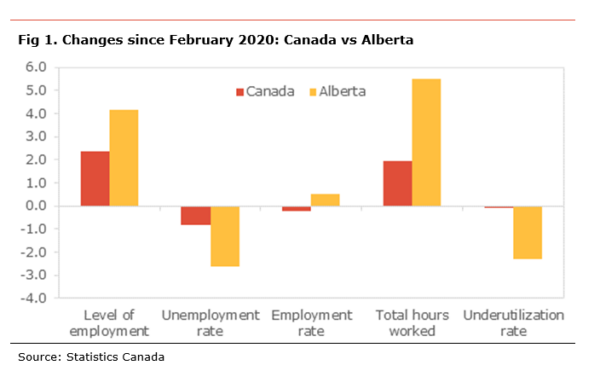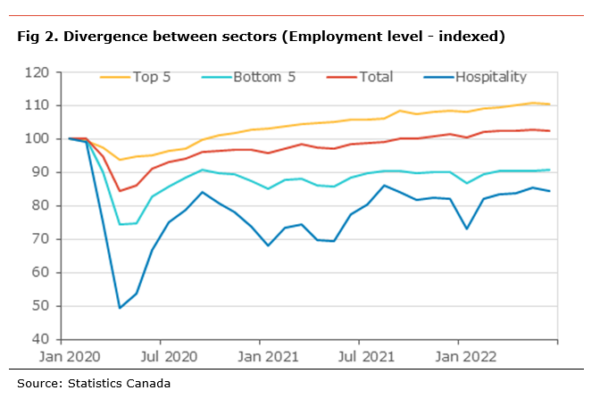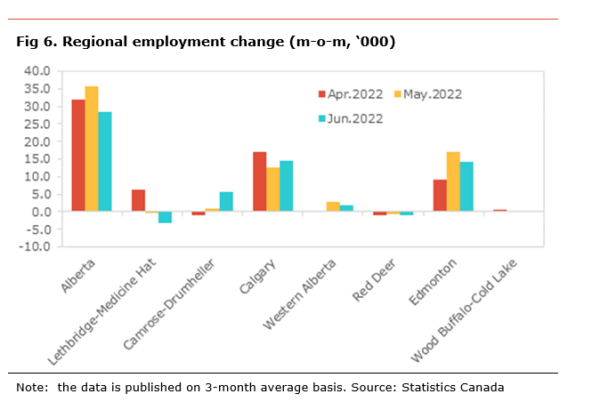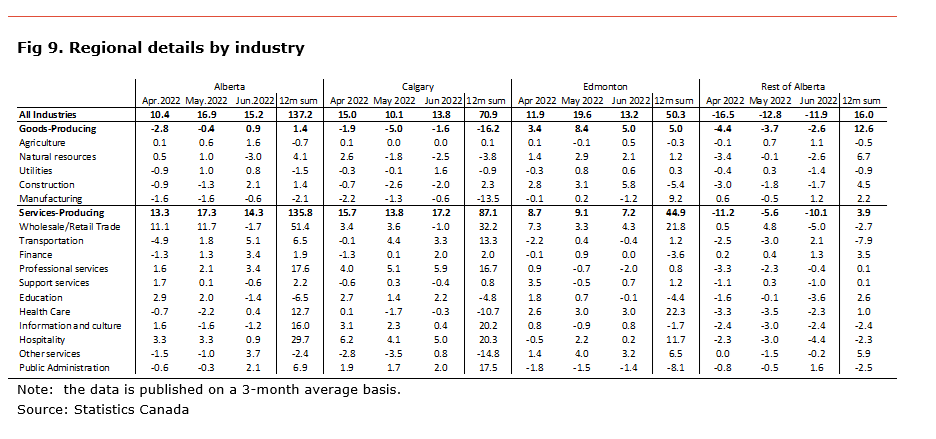Economic commentary provided by Alberta Central Chief Economist Charles St-Arnaud. This report includes regional details for Alberta.
Bottom line
Today’s Labour Force Survey data showed a surprising decline in employment. However, the details suggest that the drop in employment resulted from older workers aged 55 years old and over leaving the job market, not from layoffs due to slower economic activity. This exodus from the labour force explains the declining unemployment rate to its lowest level on record. This situation will lead to a further tightening of the labour market and exacerbate the current labour shortage.
We believe the decline in employment seen in June is unlikely to sway the Bank of Canada. Instead, the continued tightening of the labour market and high inflation support the need for aggressive rate hikes by the Bank of Canada. Accordingly, we expect the BoC to increase its policy rate by 75bp at next week’s policy meeting and by 50bp at the September and October meetings, ending the year at 3.25%.
Alberta saw a marginal gain in employment in June. The unemployment rate declined further and is at its lowest since January 2015. However, this continues to be partly the result of workers having yet to return to the labour market, as shown by the participation rate remaining below its pre-pandemic level. However, the employment rate is above its pre-COVID level, an improvement for the province’s labour market. We expect the labour market in the province to continue to improve. The continued record value of oil production should broadly support the economy and the labour market.
Employment fell by 43.2k in June, the first decline in employment since January and not related to COVID-related restrictions. Despite the drop in employment, the unemployment rate edged lower to 4.9% from 5.1%, the lowest level since records started in 1976. This was the result of a decline in the participation rate to 64.9% from 65.3%. The employment rate, the share of the population holding a job, edged lower to 61.7% from 61.9%, slightly below its pre-COVID level.
The details show that the job losses in June were mainly in part-time (-39k), with some marginal decline in full-time jobs (-4k). In addition, almost all of the decrease in employment was entirely in self-employed (-59k), while private sector jobs increased (+17k) and public sector jobs were little changed (-1k). Moreover, Statistics Canada notes that the lower level of employment in June was mainly the result of a decline in workers aged 55 years old and over.
On an industrial level, the decrease in employment was mostly in the service sector (-76k), while there was a solid gain in the goods-producing sector (+32.5k).
The details in the good-producing sector show that the higher employment was mostly in manufacturing (+26k), construction (+23k), and agriculture (+7k). These increases were partly offset by losses in natural resources (-20k).
The decline in the service industry was mixed, with losses in trade (-61k), health care (-20k), education (-14k), information, culture and recreation (-14k), and accommodation and food services (-10.5k). These decreases were partly offset by increases in public administration (+15k) and in transport and warehousing (+11k).
Despite the overall level of employment being above its pre-COVID level, only 11 out of 16 industries have a level of employment above their pre-pandemic level. The lagging sectors are: agriculture, transport and warehousing, business, building and other support services, accommodation and food services, and other services. Employment in the agriculture sector is currently almost 20% below its pre-COVID-19 level, the worst-performing industry.
In Alberta, employment was barely changed, increasing by a meager 2.0k in June. The unemployment rate dropped to 4.9%, the lowest since January 2015, and was entirely the result of a decline in the participation rate to 69.0% from 69.3%. The participation rate in the province is 1.4 percentage points (pp) below its pre-pandemic level suggesting many workers are remaining on the sidelines. The employment rate, the share of the population holding a job, inched lower to 65.6% from 65.7%, remaining above its pre-pandemic level. Similar to the national trend, we note that most of the decline in employment was in the older cohort, aged 55 years old and over.
The job gains in Alberta was mainly in the service sector (+4k), while there was a modest loss in the goods-producing sector (-2k). The decline in the goods-producing industry was in natural resources (-10.5k), while there were gains in construction (+7k) and manufacturing (+2k).
The job performance in the service sector was mixed. A decline in retail (-22k) and education (-9k) was offset by gains in most other service industries, led by other services (+10k), public administration (+7k), and finance, insurance and real estate (+6k).
Despite continued job gains and overall employment being above its pre-COVID level, only 10 out of 16 industries have a level of employment above their pre-pandemic level. Those industries are: natural resources, construction, trade, transport and warehousing, finance, insurance and real estate, professional, technical and scientific, business, building and support services, education, health care, and public administration. Employment in the accommodation and food services sector, the worst-hit industry, remains about 17% below its pre-COVID-19 level, underperforming slightly the rest of the country. Employment in the manufacturing sector is 15% below its pre-covid level, also underperforming significantly the rest of the country.
On a regional basis[1], the data is published on a three-month average basis (see table below). Over the past three months, the province gained 28.5k jobs, with most of the gains in Edmonton (+14.1k) and Calgary (+14.k). Employment also rose marginally in Camrose-Drumheller (+5.6k), and Western Alberta (+1.7k). The wre some job losses in Lethbridge-Medicine Hat (-3.4k) and Red Deer (-1.0k).
Compared to the pre-pandemic levels, Camrose-Drumheller (-4.7%) and Red Deer (-1.2%) have employment below their pre-pandemic level. Conversely, Calgary (+10.0%), Edmonton (+7.3%), Western Alberta (+3.0%), Wood Buffalo-Cold Lake (+1.9%), and Lethbrige-Medicine Hat (+1.4%) all have employment above their pre-pandemic level.
The unemployment rate for the province as a whole declined to 4.9% from 5.5%. The decrease in the unemployment rate was seen in every regions, except for Lethbridge-Medicine Hat (+0.4pp). The biggest drops were in Calgary (-1.1pp), Edmonton (-0.8pp), Red Deer (-0.6pp), Western Alberta (-0.5pp), and Camrose-Drumheller (-0.4pp). The unemployment rate is the highest in Red Deer (5.7%), Lethbridge-Medicine Hat (5.2%), Calgary (5.0%), and Wood Buffalo-Cold Lake (5.0%). It is the lowest in Western Alberta (3.1%), Camrose-Drumheller (4.2%), and Edmonton (4.9%).
The employment rate for Alberta improved to 66.4% from 65.8%. It improved in Camrose-Drumheller (+3.4pp), Calgary (+0.9pp), Edmonton (+0.9pp), and Western Alberta (+0.5pp), while it deteriorated in Lethbridge-Medicine Hat (-1.5pp) and Red Deer (-0.7pp).
[1] All the numbers are expressed as three-month average of the non-seasonally adjusted number.








Independent Opinion
The views and opinions expressed in this publication are solely and independently those of the author and do not necessarily reflect the views and opinions of any organization or person in any way affiliated with the author including, without limitation, any current or past employers of the author. While reasonable effort was taken to ensure the information and analysis in this publication is accurate, it has been prepared solely for general informational purposes. There are no warranties or representations being provided with respect to the accuracy and completeness of the content in this publication. Nothing in this publication should be construed as providing professional advice on the matters discussed. The author does not assume any liability arising from any form of reliance on this publication.